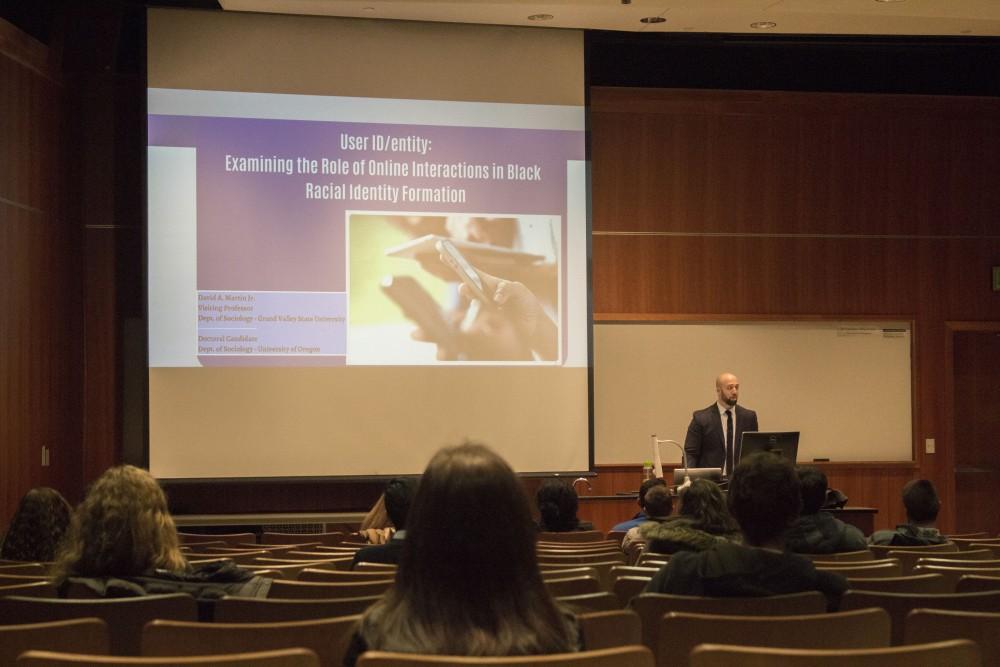GVSU alumnus studies how black students create online identities

GVL/Mackenzie Bush – The GVSU Department of Sociology presents User ID/entity: Examinging the role of online interactions in black racial identity formations, a talk by David Martin in Loutit Lecture Halls Thursday, Dec. 1, 2016.
Dec 5, 2016
It’s 7 a.m. when a single rectangle sitting on a bedside table begins to tumble and emits a blue light, filling the room. From the mess of blankets on the bed, a hand emerges and grabs the rectangle. They bring it closer to their face and begin to check Facebook.
“And just like that, we’re immersed without even thinking about it,” said David Martin, a doctoral candidate at Oregon State University and a Grand Valley State University alumnus.
In his talk titled “User ID/Entity: Examining the Role of Online Interactions In Black Racial Identity Formation” Thursday, Dec. 1, Martin introduced the findings of his doctoral dissertation and attempted to explain how young black people formed identities online.
“I developed what I call the ‘Triple A’ framework for understanding and categorizing black information in the online era,” Martin said.
The three A’s in the frame work stand for armor (whether or not those around you support you online), anxiety (exposure to attacks from posts), and affirmation (legitimizing, projecting and performing online).
Martin took a lot of inspiration from W.E.B Du Bois’ 1903 theory of double consciousness, which describes the feeling one may feel when their identity is divided up into several parts and is not singular, making it incredibly difficult to have a single unified identity.

In doing this, Martin said, he is expanding on Du Bois’ original idea and bringing it into the modern day by accounting for more modern forms of communication.
“This is valuable theoretical contribution in scholarship,” Martin said. “(Du Bois’ theory) is perfectly, beautifully written, excellently suited, rigorous scholarship that needs to be brought back into the conversation because it’s still applicable today.”
People control what they share on their social media. On some sites, they are more reserved and like and share conservatively, while on other sites, some let loose, Martin explained, and all that has to do with trying to create the way others perceive you online.
Martin has spent the past three years gathering data from over 182 participants from a pool of 1,600 “self-identified black or African-American students on campus” at OSU. Martin sent a survey out to the 1,600 students and 182 got back to him. He was able to sit down for a face-to-face interview with 47 of those students on their online posting habits, how they believe they are perceived off and on campus by members of different ethnic groups and questions similar to those.
Of the 47, Martin was given access to 41 of the participants’ social media sites. The sites given were determined by the participants and Martin used their accounts to see what they posted, how they posted and how they interacted with others on social media during different periods of the year from January of 2014 through July of 2015.
“I didn’t want to mess around (collecting) data just during finals week and have a skewed result because people are stressed out and freaking out about what type of tests are coming your way,” Martin said. “So I did the beginning, middle and end of the winter, beginning, middle and end of spring, beginning, middle and end of summer and the beginning, middle and end of the following fall.”
Reception of Martin’s dissertation was received highly among audience members.
“I thought it was informal, I’m doing this for a class and I thought it related really well to the topic we’re studying which is race, sexuality, disability and that kind of identity stuff,” said Carly Peterson, a freshman at GVSU.
The talk was part of the Colloquium Series which is a collection of three to four talks a year put on by the sociology department for the past five years. The series aims at giving students opportunities at hearing what people outside of GVSU have to say.
“Our students have a great opportunity to learn from the folks here,” said Laurel Westbrook, associate professor of sociology at GVSU. “But there are folks doing really interesting work in other places that are nearby and so we wanted to give students the opportunity to learn from the people as well.”























